Pekka Buttler, 2020–2025
This article aims to cover in detail the Exakta mount as well as its German and Japanese variations and adaptations.
Exakta mount specifications
Mount type: Symmetric1, three-pronged Bayonet (lens release on body)
Flange focal distance: 44,7 mm
Film format: 36mm x 24mm (‘Full frame’)
Mount communication: Complicated. See details below.
A very brief history of the Exakta mount
The Exakta mount has its origins in the Ihagee Kine Exakta of 1936 – a camera which in many ways paved the way for the modern concept of an SLR and is widely credited for having been the first 35 mm SLR. While the Kine Exakta was an instant hit, manufacture of the camera seized in 1940 because of the war. After the war Ihagee – the manufacturer of the Exakta – met a fate very much like that of Zeiss, meaning that there was an Ihagee both in East and West Germany, and both wanted to use the name.
Even though the war was a major spanner in the Ihagee works, and even though after the war the main manufacturer of Ihagee cameras (Ihagee East) was locked up behind the iron curtain, the Ihagee Exakta and Exa lines of cameras were a huge hit in the late 40’s and 50’s. Not only were they technologically very advanced, but also partially aided by their iconic shape, and high media profile (e.g. featuring prominently in Hitchcock’s Rear Window). As a result of the popularity of the body, Exakta lenses were manufactured in the thousands (not thousands of lenses, but thousands of different lens models). Time was, when the typical lens would always be available in two mounts: Exakta (first) and M42 (second).
Also, not only Ihagee manufactured Exakta mount cameras. While many camera manufacturers decided to develop cameras around the Exakta mount, only a few were content with using the Exakta mount as such. Instead, there are several variations/extensions of the basic 1936 exakta mount and not nearly all of those extensions are mutually compatible (see epilogue). The Exakta mount stayed in active use to the end of the 1970s.
Variants (and identification):
Main variants:
• Manual Exakta
• External Exakta
• Semi-automatic Exakta
• Auto-Exakta
• Topcon Exakta
• Mamiya Exakta
• Exakta RTL 1000
Manual Exakta (1936->)
The original (manual) Exakta mount was launched together with the original Kine Exakta in 1936. It is a male bayonet mount2 with a relatively narrow throat diameter (ca 33,8 mm). This male bayonet is in Exakta parlance also referred to as the inner or internal bayonet.
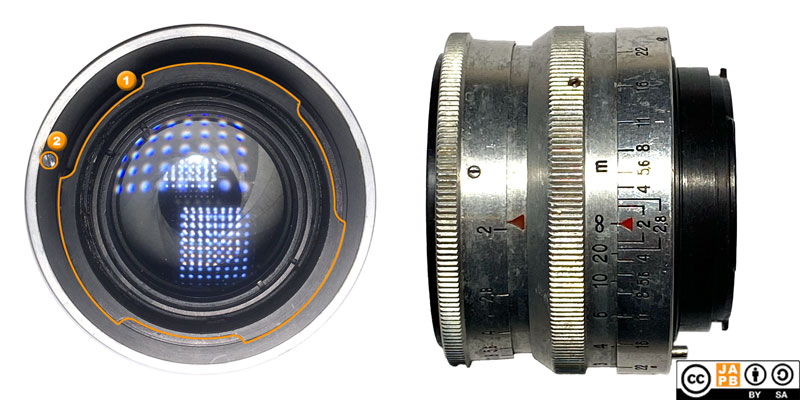
Identifying traits:
[1] Three-pronged bayonet.
[2] Locking pin.
The manual Exakta mount is characterised by no affordances for lens-body communication.
External Exakta (1951->)
To accommodate the mounting of larger (heavier) lenses, the inner (male) bayonet was later extended with a larger-diameter, external (female) bayonet. Typically you will find the external bayonet used only on longer tele lenses. Lenses using the inner bayonet could be used in identical fashion whether the camera has an external mount or not.

Mount elements (camera):
[3] Three-pronged (inner) bayonet.
[3b] Three-pronged (outer) bayonet 3
[4] lens release lever (spring-loaded)
[5] Shutter release button
[6] Shutter release guard4
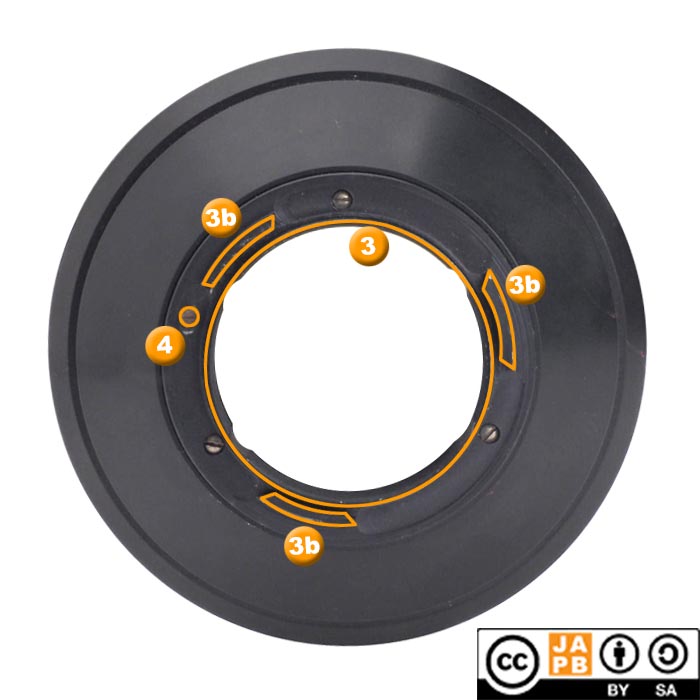
Mount elements (lens):
[3] Straight throat (goes into lens mount to add stability)
[3b] Three-hooks to latch onto (outer) bayonet
[4] Lens locking pin
Exakta Semi-auto (with pass-through) (ca. 1951–1959)
Like some5 early post-war systems, also some Exakta mount lenses used semi-automatic aperture mechanisms before transitioning to fully automatic apertures.
These lenses combined a pod-like structure (see below) for stopping down the aperture before triggering the shutter, with a manual swing lever for opening up the aperture after the shot. While Semi-automatic lenses for the Exakta mount were manufactured by a handful of manufacturers, Carl Zeiss Jena was the most prominent user of this mechanism and you can find a range of Tessars, Biotars and Flektogons in semi-automatic housings.
[I do not own a copy of a semi-automatic Exakta lens, so I will have to refer you to other online sources 6 for images]
Exakta Auto (with Pod) (ca. 1956->)
The likely most iconic version of Exakta lenses are the 1960s Exakta lenses that have ‘the Pod’. The Pod is sometimes also referred to using its technical acronym: PAD (Pressure-activated diaphragm).

The Pod was an extension designed to give the Exakta lenses auto aperture abilities. While the physical mount of these lenses is identical with the manual Exakta lenses (see above), the Pod was designed to rest on top of the Exakta body’s shutter release (see below).
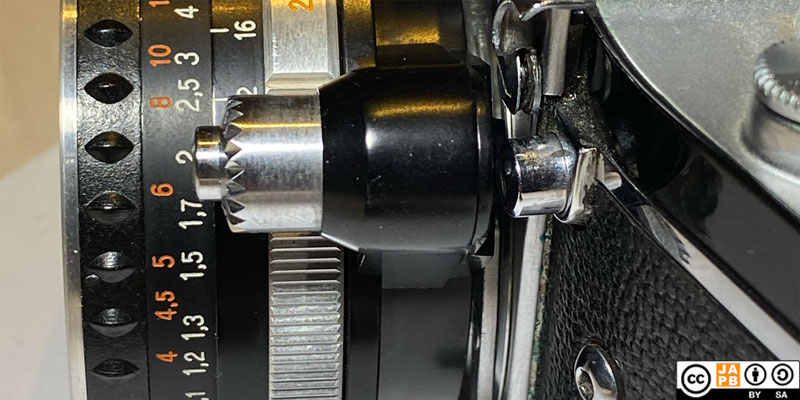
The ‘Pod’ is a pass-through device. Instead of pressing the shutter button to take a shot, the photographer would press the (silver-colored part of ) the Pod. This in turn had a two-stage motion where at the first stage it would stop down the lens to whatever aperture value the photographer had set, while at the second stage it would depress the shutter release button on the body.
Importantly, the Pod was not an auto-aperture-only arrangement, as you could half-press the pod (until the aperture stops down), then twist the front of the pod and it would lock in aperture close-down mode (effectively giving you a manual aperture lens). This is crucial for being able to ergonomically use Exakta lenses with pods as adapted lenses.
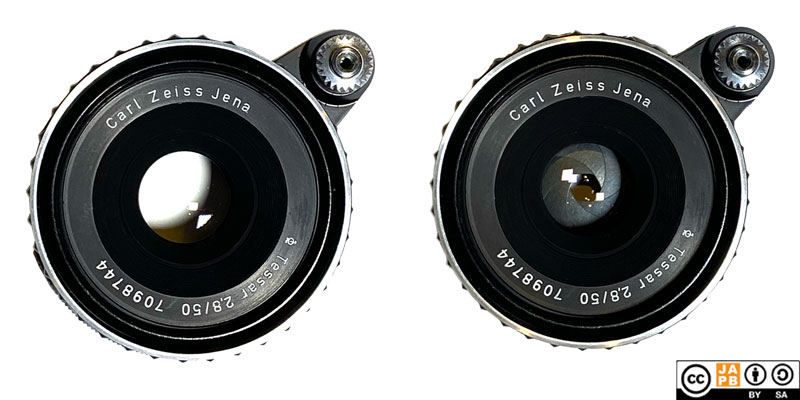
Right: CZJ 50/2.8 Tessar locked in manual aperture mode
Exakta Auto (with Springboard) (ca. 1960->)
The Pod was a practical and elegant solution to add aperture automation to a wide range of exakta cameras. But it also was over-engineered in the way only Germans know how. Unsurprisingly, another approach for achieving the same result was also devised, and while it does not seem to have an established name, I refer to it as the ‘springboard’.

Right: Same lens mounted on Exakta Varex VX
Characteristics:
[7] The springboard
[8] Cut-out in mount flange to make space for knob on lens release lever. These were necessary on large-diameter lenses.
While simpler (and less elegant), it fundamentally offered the same functionality. If you pressed the springboard a few millimetres, it would stop down the lens, if you pressed it all the way, it would depress the shutter release on the camera. When you released the springboard, it bounced back (hence the moniker). This approach however did not offer an interface for choosing between manual and automatic aperture. Hence, if a lens wanted to offer the photographer a choice, the lens needed to sport a ring to facilitate that choice. Not all lenses that used the springboard offered a ring for setting the lens to behave like a manual lens, but the Trioplan N has such a ring (see data sheet).
Topcon Exakta
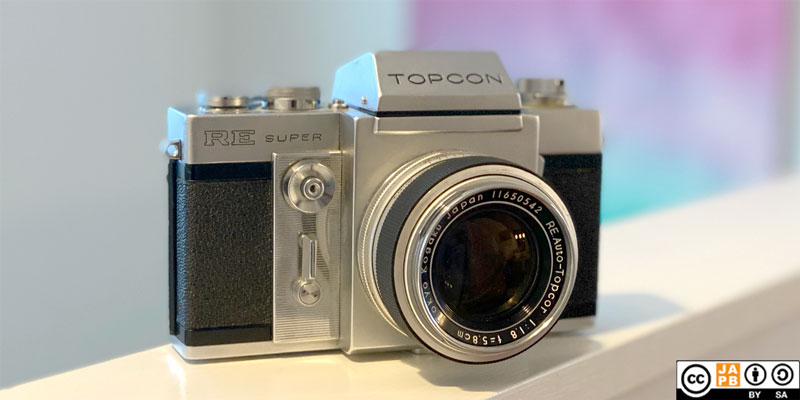
Topcon of Japan (company profile here) decided to participate in the battle for market dominance in the SLR segment. In 1957 Topcon Launched the Topcon R SLR – a very ambitious bid in terms of integrating the latest technology and SLR design concepts. Likely to be able to draw upon the wide range of existing lenses, Topcon decided on the Exakta mount (instead of the M42 mount or a new proprietary mount).
However, Topcon did not use the Exakta mount as such, nor did they copy the European extensions to the Exakta mount. Instead, Topcon devised a number of different extensions to the Exakta mount.
The Topcon R camera could be used with manual and preset Exakta lenses without issues, but Topcon also wanted to launch their own lenses to match their marvel. For this purpose, Topcon launched two lines of lenses: The Auto-Topcor line and the R.Topcor line.
The Topcon R was replaced in 1960 with the Topcon R II (and in 1961 with the Topcon R III Automatic). These abandoned the Auto-Topcor line of lenses and instead introduced the F.Topcor line of lenses. The R.Topcor preset lenses remained in use.
1963 saw the introduction of the Topcon RE Super and the introduction of RE.Auto Topcor lenses. With the exception of a select few7 R.Topcor preset lenses, all existing preset lenses were redesigned and offered as RE.Auto Topcor lenses. The RE Super started a golden decade for Topcon, and the mount did not change before Topcon’s withdrawal from the camera business two decades later.
Auto-Topcor
For the Auto-Topcor line Topcon devised their own variant of the Pod, and placed in an entirely different place (we do not have a copy of the Topcon R on hand and can not offer an image. Look here instead.). These lenses (focal lengths: 35, 58 and 100) were known simply as Auto-Topcor lenses.
Auto-Topcor lenses are semi-automatic aperture lenses, meaning that while the aperture would be automatically stopped down to the intended aperture just prior to taking the picture, opening up the aperture after the picture was taken was not automatic. Instead, Auto-Topcor lenses were equipped with a lever to open up the aperture again.
Importantly, while the Topcon R’s shutter button and auto Pod’s placement meant that Exakta and Auto-Topcor Pods were by no means compatible, there were some other incompatibilities as well. From the first version of Topcon’s implementation of the Exakta mount, Topcon has added a ‘skirt’ to the mount (see picture below). Whether the purpose of that skirt has been to help close the gap between lens and body, I cannot say, but that skirt collides with most Exakta pods (see above), leading to that many Auto- Exakta lenses cannot be mounted on a Topcon R/RE body.
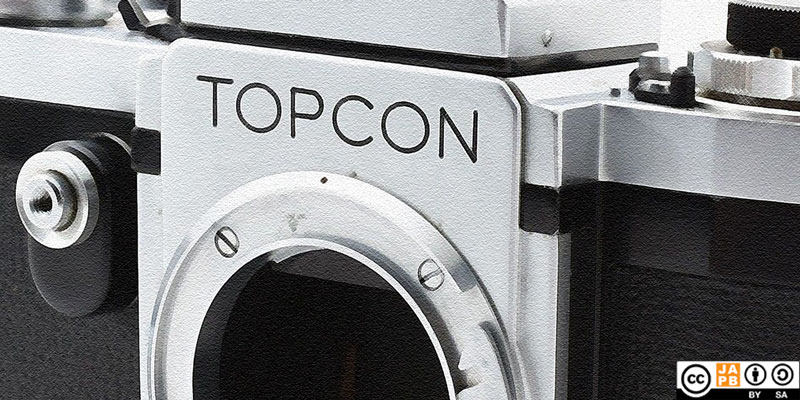
R.Topcor
R.Topcor lenses were preset aperture lenses, introduced to complement the Auto-Topcor range on the first generations of Topcon cameras. The entire lineup of R-Topcor lenses is: 50/2.8, 90/3.5, 135/3.5, 135/2, 200/4, 300/5.6, 300/2.8
With the exception of a slow fifty, all of these are tele lenses, which early on posed significant issues for auto aperture systems.
F.Auto-Topcor
F.Auto-Topcor lenses were intended to be automatically stopped down by the camera and open up again after having taken the shot (fully automatic aperture). To facilitate this, F.Auto-Topcor lenses (and bodies) had a lever for facilitating aperture stop-down between the lens’ mount and the skirt.
What the F.Auto-Topcor lenses (and mount) however lacked were the ability to communicate the selected aperture to the camera body.
RE.Auto-Topcor
In 1963 Topcon introduced the Topcon RE Super, which not only had all the features of the predecessor models, it included a lever to act as aperture feeler (able to read the aperture ring’s selected value). This arrangement stayed practically identical (and is typically referred to as the Topcon RE mount) until Topcon quit the camera business in the 1980s.
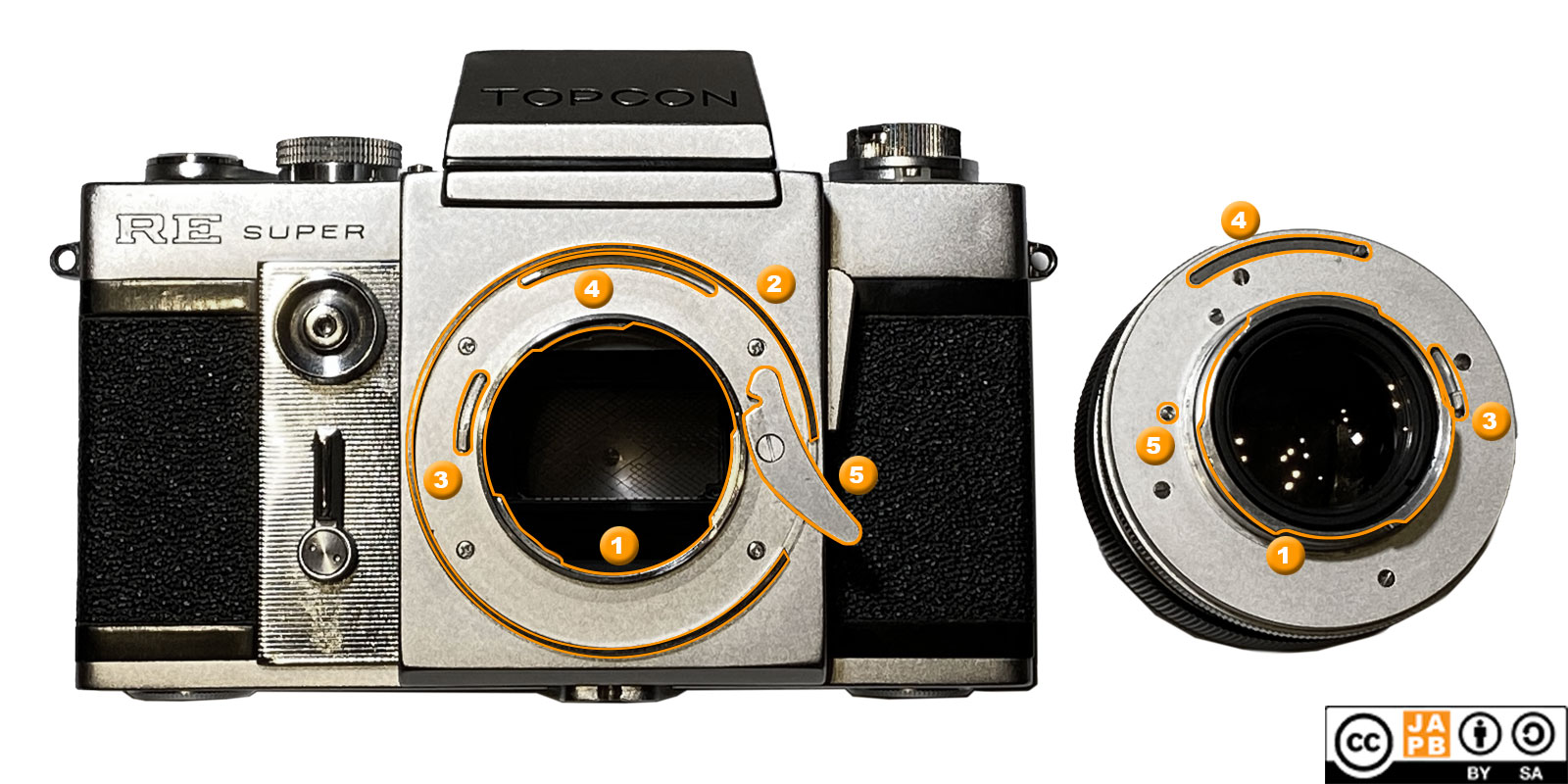
Elements of the Topcon RE mount
[1] Three pronged male bayonet
[2] Outer ‘skirt’ to protect the levers from dust etc.
[3] Aperture stop-down lever (body-to-lens)
[4] Aperture feeler (lens-to-body)
[5] Lens release lever and locking pin
One noteworthy aspect is that some Topcon RE-series cameras differed regarding the placement of the skirt [2], as with some cameras the skirt was ‘inside of’ the aperture feeler arrangement.
Mamiya Exakta
In 1961 Mamiya introduced its contender for the booming SLR market: The Mamiya Prismat. The Mamiya Prismat (and a few of its successor models) use an Exakta mount. The earliest Mamiya Prismat’s even offer both the internal and the external bayonet, but the external bayonet was soon dropped.
In contrast to both East German and Topcon’s contemporary implementations of auto aperture (Pods and springboards, in other words various approaches to create pressure-activated diaphragms), the Mamiya Exakta cameras do it the other way around: Instead of putting the shutter release on the front of the camera in order to be able to put a Pod or a springboard in front of it, the Mamiya Prismat had a traditional shutter release on the top of the camera in a customary location and instead offered a pin on the right-front of the camera housing that would interact with with a ‘reverse PAD’ on the lens. In other words:
1) Photographer presses shutter button half-way ==> Pin extends from the body and activates the reverse PAD mechanism on a compatible lens ==> Lens is stopped down to taking aperture;
2) Photographer presses shutter button all the way ==> Mirror up, focal plane shutter opens, closes, Mirror down8
3) Photographer actuates lever on lens to open the aperture back up and prime the reverse PAD mechanism (semi-automatic aperture).
The Mamiya Prismat series was not especially successful and a significant share of the bodies were rebranded as Sears ‘Tower’ cameras. Subsequently, Mamiya abandoned the Exakta mount and started on a journey described in the JAPB article on All Mamiya 35 mm SLR mounts.
Exakta RTL 1000
Towards the end of the 1960s there was a final attempt to breathe life into the ailing Exakta line of cameras in the form of the Exakta RTL 1000 (1969). The Exakta RTL 1000 was produced by Pentacon alongside the Praktica L line of cameras.
While the Exakta RTL 1000 inherits a lot of its basic technology from the Praktica line, its materials and workmanship were clearly intended to be a cut above the basic Prakticas. The Exakta RTL 1000 retains the Exakta mount, but a new version of the Exakta mount.
The Exakta RTL 1000 mount combines the basic idea of the 1936 Exakta mount (a simple, internal bayonet mount) with the external bayonet and an aperture stop-down pin (most prominently used by automatic variants of the M42 mount).
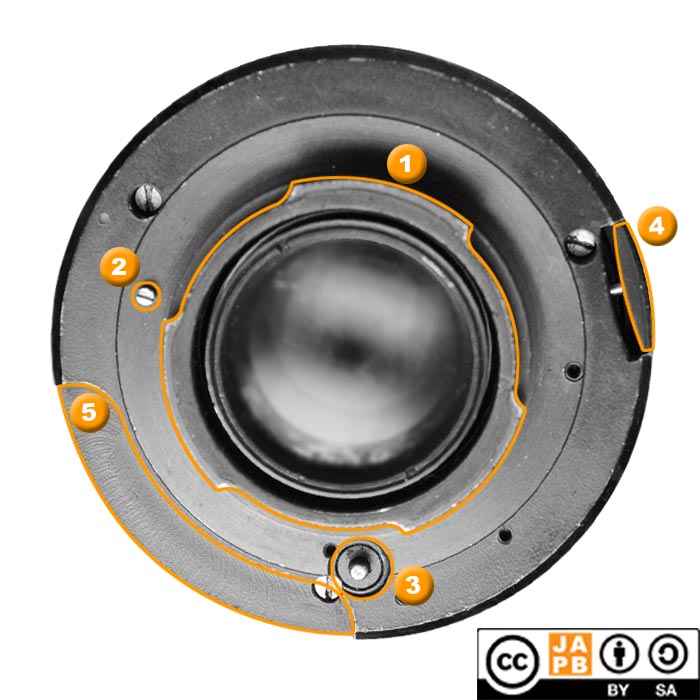
Elements of the RTL 1000 version of the Exakta mount:
[1] Vanilla Exakta inner bayonet mount.
[2] Vanilla Exakta locking pin.
[3] RTL 1000-specific aperture stop-down pin
[4] Depth-of-field preview button
[5] Cut-out for compatibility with older Exakta cameras (with a small knob on the lens release lever)
The Exakta RTL 1000 was by all accounts a good, reliable camera, but it was too little too late. There was even a level of infighting involved, because even though the Exakta RTL 1000 was clearly pitched as a premium camera, it was at the time of its launch technologically behind not only most of the Japanese competitors, but even behind the in-house competition in the form of the Praktica LLC which not only offered open-aperture metering, but did this electronically. As a result, it was discontinued after only four years and with a relatively limited set of lenses9 ever having been manufactured with the dedicated stop-down pin.
Other Exakta variants
There are a number of relatively obscure Exakta variants, for which I refer you to the research of Hugo Ruys.
Adapting Exakta-lenses
Rationales
In case you need convincing why Exakta lenses are interesting for someone using legacy lenses on modern cameras, let me try:
One. Exakta-mount lenses go as far back as the pre-war era, and Exakta cameras (and lenses) had their heyday before the dominance of the Japanese SLR. This means that the Exakta-mount (more than any other) opens a window into a time when Germany (pre-war as well as East and West) were the undisputed kings of cameras and optics. As a result of this, Exakta is one of the go-to -mounts (the other being M42) for lenses by as diverse a range of German manufacturers as Carl Zeiss Jena to Rodenstock; Meyer-Optik to Schneider Kreuznach as well as many less well known manufacturers such as Enna, ISCO, Kilfitt, Piesker, Schacht, Steinheil … Moreover: As Exakta lenses have traditionally been less easily adapted, partially due to the convolution inherent in the way the mount evolved, many classic lenses that are available in both M42 and Exakta mounts, can regularly be had more cheaply in Exakta-versions. Often way more cheaply…
Two. After the Japanese adoption of the Exakta mount, also several early Japanese manufacturers offered lenses for the Exakta mount. In spite of the limitations10 defined by the size of the mount, the Exakta-mount even for some time carried the fastest serial-produced lens of its time – the fabled Taika Harigon 58/1.2.
Three. Topcon (See company profile here) used its variant of the Exakta mount – the RE.Auto Topcor or colloquially Topcon-RE mount – as basis for its professional line of lenses and cameras and that line holds some of the finest 1960s-70s Japanese optics.
Practicalities
There are basically two versions of this story: Vanilla Exakta and … well … weird Exacta. And then there are two types of audiences: Mirrorless users and dSLR users. First, I’ll talk to the mirrorless audience:
On mirrorless, Early Exakta lenses (direct coupling aperture control or preset aperture control) are easy as pie. You buy any old Exakta to <your mirrorless camera mount> dumb adapter (I use one I bought on aliexpress for <10€ ), mount your lens, and boom!
‘Auto’ Exakta lenses (those with Pods or springboards sticking out of the side of the lens) are no different. Assuming the pod works as it should (It should allow you to lock the aperture in manual mode). Lock the lens in manual mode, mount, and boom! Also, most lenses that offer springboards also enable you to put the aperture in manual mode. Again: boom.
Topcon Exakta11?
• RE.Auto Topcor lenses work on any Exakta adapter (I use them all the time).
• F.Auto Topcor lenses, the same should apply (although I have never had a chance to try).
• R.Topcor lenses are preset lenses and pose no issues.
• Auto-Topcor? I have honestly no idea. It all depends on whether you can facilitate or jury-rig the aperture to work in manual mode12.
Regarding Mamiya Exakta lenses, the big question is again, whether you can facilitate or jury-rig the aperture to work in manual mode. These lenses seem to be very rare and I have found no one to ask (and do not fancy paying three figures just to find out).
External Exakta-mount lenses? Ouch. Only if you’re comfortable with making a DIY adapter…
How about dSLR’s?
With the relatively short flange focal distance of the Exakta mount (44,7 mm), you’re in luck if your dSLR’s mount is Canon EF, in which case you can use a dumb adapter (with all the caveats mentioned above), but as all other dSLR either have prohibitive flange focal distances, you’ll either have to accept an adapter with optics (such are currently available al least for Nikon F, Pentax K and Sony A) or accept a crop factor (there used to be adapters for FourThirds, and you might still find one 2nd hand)
Epilogue
How about using Exakta mount lenses on film cameras? Absolutely.
As long as you want to keep within the original systems, your main challenge is to find a working body and even that is far from difficult. While Exakta kameras were not always well-maintained by their users, there were millions made, and even I managed to snag a beautiful Varex VX without trying (it came at the price of a lens’ body cap). Topcon cameras were known for their workmanship and reliability13 and seem to stand the test of time really well.
But if you want to use optics from one Exakta variant on another variant’s camera? Let’s start with the easy ones (and I’m not going to cover all the alternatives).
Say you have a Topcon camera and you want to try out some East German optics. No problem as long as we’re talking about manual or preset lenses or an auto Exakta lens with a springboard and the ability to set it in manual aperture mode. Your metering will even work in stop-down mode.
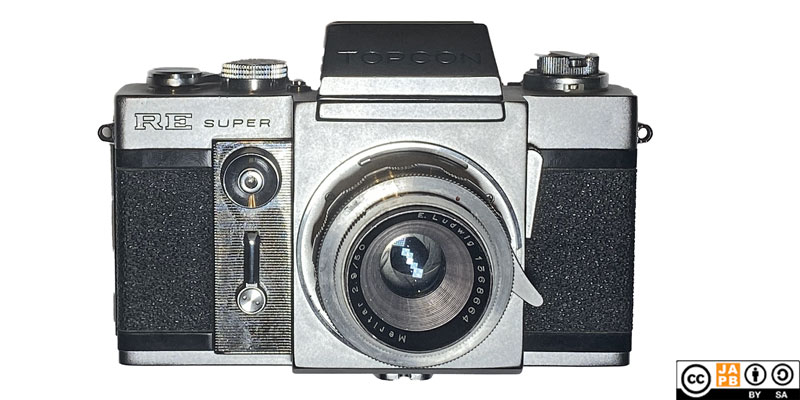
There is however a problem with Auto Exakta lenses that have the Pod, because a small protrusion on the Pod’s arm collides with the outer skirt on the Topcon lens mount (see below)

How about using Topcon lenses on an Exakta body? There are two considerations: Will you be able to control the aperture and will the lens mount?
Your most likely candidate are RE.Auto Topcor lenses (because they are most plentiful) and here the aperture will be usable, but – depending on the Exakta body you might have trouble mounting the lens due to collision with the Exakta camera’s lens release lever (see below).
F.Auto Topcor lenses are no problem because their flange-end has the same cutout as the RTL 1000 lenses (pictured above), and their aperture mechanism will also work.
R. Topcor lenses are manual/preset lenses so their apertures will work without issues. Also, their structure is such that collisions with parts of Exakta cameras are unlikely.
Auto-Topcor lenses are a mystery to me. I’ve studied pictures of Auto-Topcor lenses on online classifieds and I can see nothing that would make mounting an Auto-Topcor lens on a typical Exakta camera impossible. Also, I cannot give any concrete information of whether it is possible to get an Auto-Topcor lens to behave as if it was a manual aperture lens.
- Symmetric means that the size and spacing of the bayonet prongs and openings is such that you can accidentally mount the lens in several angles (but only one will engage the locking pin). ↩︎
- “Male bayonet mount” means that bayonet goes inside of the corresponding parts on the camera. ↩︎
- Not present on all Exakta bodies. ↩︎
- Move this down over the shutter release button to guard against accidental shutter release. ↩︎
- Including (prominent examples): Pentax/Takumar, Topcon, Praktina. ↩︎
- See e.g.: Link1, Link2, Link3 ↩︎
- Notably the Topcor.R 135/2 and 300/2.8 preset lenses. ↩︎
- The earliest Mamiya Prismat bodies did not have an auto return mirror. Then you would typically need to wind the camera to return the mirror back down. ↩︎
- I have seen photographic evidence of only the following: CZJ 50/1.8 Pancolar; MOG 29/2.8 Orestegon; MOG 50/1.8 Oreston; MOG 100/2.8 Orestor; ↩︎
- Like many older mounts, the Exakta-mount is relatively small. The inner diameter of the mount is merely 32,5 mm, and the outer diameter (prongs included is 37,5 mm). This makes the mount actually narrower that the M39 rangefinder mount and places a significant limitation on the size of a lens’ rearmost optic. ↩︎
- Please not that UV Topcor lenses use an entirely different mount which is addressed here. ↩︎
- I’ve never held an Auto-Topcor lens and cannot but offer speculation – albeit informed by reading Topcon R manuals – regarding the lens’ ability to emulate a manual aperture lens. Based on manuals there should be at least a procedure that involves a) setting the taking aperture, b) cocking the semi-automatic aperture, c) triggering the stop-down, but nothing in the manuals indicates that – once triggered – the diaphragm obeys the aperture ring. Instead there is a sentence in the Topcon R manual that says: “Only the pressure on the extended shutter release or the automatic diaphragm release can stop down the aperture to its preselected opening” ↩︎
- Legend has it that the Topcon RE Super (aka. Beseler Topcon Super D) was chosen as the US Navy’s and US Airforce’s combat camera after having bested the likes of the Nikon F. ↩︎